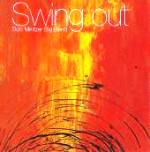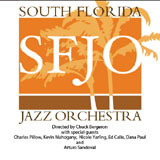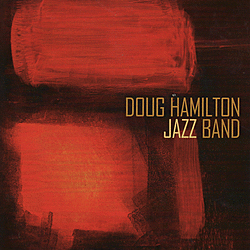Home » Jazz Articles » Bailey's Bundles » By Arrangement Only: Bob Mintzer, Chuck Bergeron, Carl S...
By Arrangement Only: Bob Mintzer, Chuck Bergeron, Carl Saunders & Doug Hamilton
An example of this is the Miles Davis Nonet's 1949 recording of Denzil Best's "Move." "Move" was arranged by John Lewis, who was later to become pianist of the long-lived Modern Jazz Quartet. It is a study in arranging for a medium sized band, transforming the hot be-bop of the composition's original intent into something less radioactive. Lewis effectively smooths out all of the bop rough spots, producing a pliable ensemble piece. The big band recordings dealt with here accomplish much the same thing. That is to say they transform composition, both original or standard, into something new.
 Bob Mintzer Big Band
Bob Mintzer Big Band
Swing Out
MCG Jazz
2008
Saxophonist Bob Mintzer divides his time between the adult contemporary jazz group, the Yellowjackets, and his award winning big band. A Mintzer big band offering is something to anticipate because of the care Mintzer takes in his crafts of composition and arrangement. His most recent MCG Jazz recordings, Live at MCG with Kurt Elling(2004) and Old School: New Lessons (2006) both were well received and illustrate Mintzer's dedication to his big band craft.
Swing Out continues this trend with a recording heavy on Mintzer originals. Mintzer follows in the steps of American classical composers Aaron Copland, Charles Ives, and Virgil Thompson, who all spun American folk melodies into their work. In the jazz field, Oliver Nelson was particularly adept at this cultural incorporation. Mintzer effectively extends Nelson's language with the compositions "Each Day," Swangalang," and "Beyond the Limit." These pieces echo Nelson compositions like "Stolen Moments," "Yearnin,'" and "Hoe Down" from his masterpiece, Blues and the Abstract Truth (Impulse!, 1962). All of these pieces display elements of Americana in their thematic development and reconciliation.
Mintzer's writing also contains angular elements, particularly in his arrangements of standards. On Swing Out Mintzer addresses Arlen/Mercer's "My Shining Hour" and Churchill/Morey's "Someday My Prince will Come." Mintzer's treatment is both stylish and swinging. The icing on the cake is an abstract reading of the Elling/Mays/Metheny composition, "Minuano," sung by Elling himself. Elling and Mintzer have found soul mates in one another and their continued collaboration bears sweeter and sweeter fruit.
Visit Bob Mintzer on the Web
 South Florida Jazz Orchestra
South Florida Jazz Orchestra
South Florida Jazz Orchestra
MAMA Records
2008
The South Florida Jazz Orchestra is a 17-member big band and as such has a big sound. Led by bassist Chuck Bergeron, the orchestra debuts with this eponymous release on the big band oriented MAMA Records. SFJO's sound is characterized by its low brass and reeds with muted or brassy brass on top. The band has an understated Latin flavor to it, particularly on the standard "Nature Boy" (which features Kevin Mahogany in fine voice) and Ernesto Lecouna's "Siboney." But that is getting ahead of ourselves.
The disc opens with alto saxophonist/arranger Gary Lindsey's "Blues Gumbo," featuring fine solos by Mike Brignola on baritone saxophone, Steve Sigmund on trombone, and guest Arturo Sandoval on trumpet. Bergeron's "Role Model" follows, bottom heavy with Mike Brignola's bass clarinet and an extended solo by saxophonist Charles Pillow. Joe Zawinul's "Midnight Mood" channels Glenn Miller into the 21st Century as a floating ballad that features Alex Norris' trumpet and Gary Lindsey's trombone.
Oscar Levant's "Blame it on my Youth" is well served by Joe Williams protege Nicole Yarling on vocals and violin, and Dante Luciani on trombone. Leader Bergeron shines with his low brass and reeds on Mike Lewis' ..."Ant The Basses Are Loaded." Again, Brignola's bass clarinet is in conspicuous evidence. Tenor saxophonist Ed Calle guests on "This Can't Be Love" with vocalist Dana Paul to grand effect. South Florida Jazz Orchestra is a full-bodied, straight-down-the-middle big band offering that is not populated with the standard BB fare. It will appeal to the conservative and adventuresome in equal measures.
Visit South Florida Jazz Orchestra on the Web
 The Carl Saunders Exploration
The Carl Saunders Exploration
The Lost Bill Holman Charts
MAMA Records
2008
There is a bit of a story associated with The Lost Bill Holman Charts. In the early 1980s, geologist/saxophonist Ted Richardson hooked up with college roommate Woody James and began to cultivate the idea of assembling a septet to record a collection of arranger Bill Holman's charts. Holman prepared the charts and the project was shelved, said charts stored in Richardson's closet. In 2005, Carl Saunders met Richardson as part of a Stan Kenton Reunion tour. Richardson spoke of the Holman charts and Saunders asked to see them. This album is the result.
What is so special about Bill Holman? In the academy of jazz arrangers, Holman may be the Dean of the school. Long associated with the West Coast movement in jazz, Holman wrote for trumpeter Shorty Rogers and drummer Shelly Manne. In the 1960s, Holman broadened his writing commitments to include contributions to other bands, and eventually contributed pieces to libraries and recordings of bands led by Louie Bellson, Count Basie, Terry Gibbs, Woody Herman, Bob Brookmeyer, Buddy Rich, Gerry Mulligan, and Doc Severinsen. Holman also wrote for singers Natalie Cole, Tony Bennett, Carmen MacRae, Mel Torme, Woody Herman, Anita O'Day, Sarah Vaughn, and June Christy.
Trumpeter and flugelhornist Carl Saunders assembled his own septet, christened the Carl Saunders Exploration. This group recorded all of the charts prepared for Ted Richardson and one composed by Saunders and arranged by Holman. The results are previously unheard Bill Holman. We may take it for granted that the arrangements are uniformly fine. Saunders' dedication to the project is evidenced in the swinging "Three Little Words," (featuring a cool West coast solo by the leader), Saunder's own "The Hook," and Holman compositions "Hannibal" and "Scratch." Holman could make the smallest ensembles sound larger than life and his contribution to the Carl Saunders Exploration is no exception.
Visit Carl Saunders Exploration on the Web
 Doug Hamilton Jazz Band
Doug Hamilton Jazz Band
Doug Hamilton Jazz Band
OA2 Records
2008
Doug Hamilton is a Toronto surgeon, trombonist and the founder and leader of the Brass Connection that was active during the 1980. Hamilton organized his Jazz Orchestra in 1993 with 10 pieces, to play arrangements by himself and Mark Taylor. The band features primarily musicians from the US Military Jazz Ensembles. Hamilton is very arrangement oriented, having been inspired by the 1950s Stan Kenton Orchestra and arrangers such as Bill Holman and Hamilton's partner, Mark Taylor. The Jazz Orchestra possess an over-the-top, suave sound bigger that its 10 participants. This is true, in part, to the large drumming presences of Dave McDonald and Steve Fidyk, who can provide a percussive wall of sound or a sotto voce accompaniment as appropriate.
This is a release notable for its fine arranging. Hamilton both composed and arranged "Modal Blues," owing a tremendous debt to Miles Davis' "So What" and "All Blues." The piece features bookended bass figures by bassist Paul Henry as well as solo turns by trombonist Matt Neiss and baritone saxophonist Scott Silbert. Mark Taylor's crisp rendering of Sonny Rollins' "Oleo" is spry with bop convention in solution with big band swing. "Scarborough Fair" emerges from a bass offbeat, crystallizing unexpectedly into a pastoral guitar-piano duet punctuated with full band 4/4 asides that will make the listener think of the structure of Dave Brubeck's "Blue Rondo a la Turk." The soloing all takes place over the 4/4 walk before returning to the Bachian counterpoint of the horns, guitar, and piano.
"Styptic Pencil" is a Doug Hamilton arrangement of an Ian McDougall interpretation of "I'm Getting Sentimental Over you," and swings freely in spite of (or perhaps because of) its careful orchestration. The disc's highlight is a very compelling "My Funny Valentine." This warhorse is so throughly transformed that the listener must pay close attention to how the melody is being presented. It begins with a Hamiltonian counterpoint between pianist Tony Nalker and guitarist Jim Roberts, dissolving into a lengthy solo by Roberts. The melody is appropriately AWOL making this arrangement hark back to Charlie Parker's recording of "Embraceable You" where the altoist dispensed with the melody right out of the shoot. It is only during Nalker's solo that the tune becomes overt. This is what great jazz is all about.
Visit Doug Hamilton Jazz Band on the Web
Tracks and Personnel
Swing Out
Tracks: Swing Out; Each Day; Something Else; Swangalang; Beyond The Limit; Minuano; My Shining Hour; Freedom Song; Someday My Prince Will Come.
Personnel: Lawrence Feldman, Peter Yellin: flute, alto saxophone; Bob Malach: clarinet, tenor saxophone; Roger Rosenberg: clarinet, baritone saxophone; Scott Wendholt: trumpet, flugelhorn; Jim Rotondi, Bob Millikan, Frank Greene: trumpet; Michael Davis, Keith O'Quinn, Larry Farrell: trombone; Davide Taylor: bass trombone; Phil Markowitz: piano; Jay Anderson: bass instrument, upright bass; John Riley: drums.
South Florida Jazz Orchestra
Tracks: Blues Gumbo; Role Models; Nature Boy; Siboney; Midnight Mood; Touch & Go; Blame It On My Youth; ...And The Basses Are Loaded; This Can't Be Love; Waltz For Tikkaroo; Kong's Garden.
Personnel: Gary Lindsay: clarinet, alto saxophone; Mike Brignola: bass clarinet, baritone saxophone; Gary Keller: soprano saxophone, alto saxophone; Jason Kush, Ken Mattis: tenor saxophone; Augie Haas, Rodrigo Gallardo, Alex Norris, Jason Carder: trumpet; Noah Bellamy, Dante Luciani, Steve Sigmund, John Kricker: trombone; Joe Barati: bass trombone; Doug Bickel, Brian Murphy: piano; Chuck Bergeron: bass instrument; John Yarling: drums; Kevin Mahogany; vocals, baritone; Dana Paul, Nicole Yarling: vocals; Ed Calle, Charles Pillow: saxophone; Arturo Sandoval: trumpet.
The Lost Bill Holman Charts
Tracks: Three Little Words; Ow; Mahogany Run; Primrose; Dearly Beloved; The Hook; We'll Be Together Again; All Too Soon; Doctor Deep; Hannibal; Scratch.
Personnel: Carl Saunders: trumpet, flugelhorn; Pete Christ lieb: tenor sax; Bob Efford: baritone sax; Andy Martin: trombone; Christian Jacob: piano; Kevin Axt: bass; Santo Savino: drums. Guest soloist: Sam Most: flute, baritone sax.
Doug Hamilton Jazz Band
Tracks: By Myself; Up Jumped Spring; Modal Blues; I Love You; Paula; Oleo; That's All; Scarborough Fair; Styptic Pencil; My Funny Valentine; Samba.
Personnel: Bill Linney: alto; Tedd Baker: tenor; Scott Silbert: baritone; Jim Roberts: guitar; Craig Fraedrich, Liesl Whitaker: trumpet; Matt Niess: trombone; Tony Nalker: piano; Paul Henry: bass instrument; Dave McDonald, Steve Fidyk: drums; Doug Hamilton; Mark Taylor; Rick Wilkins: arrangers.
< Previous
Tie It In
Comments
Tags
For the Love of Jazz
 All About Jazz has been a pillar of jazz since 1995, championing it as an art form and, more importantly, supporting the musicians who create it. Our enduring commitment has made "AAJ" one of the most culturally important websites of its kind, read by hundreds of thousands of fans, musicians and industry figures every month.
All About Jazz has been a pillar of jazz since 1995, championing it as an art form and, more importantly, supporting the musicians who create it. Our enduring commitment has made "AAJ" one of the most culturally important websites of its kind, read by hundreds of thousands of fans, musicians and industry figures every month.


















